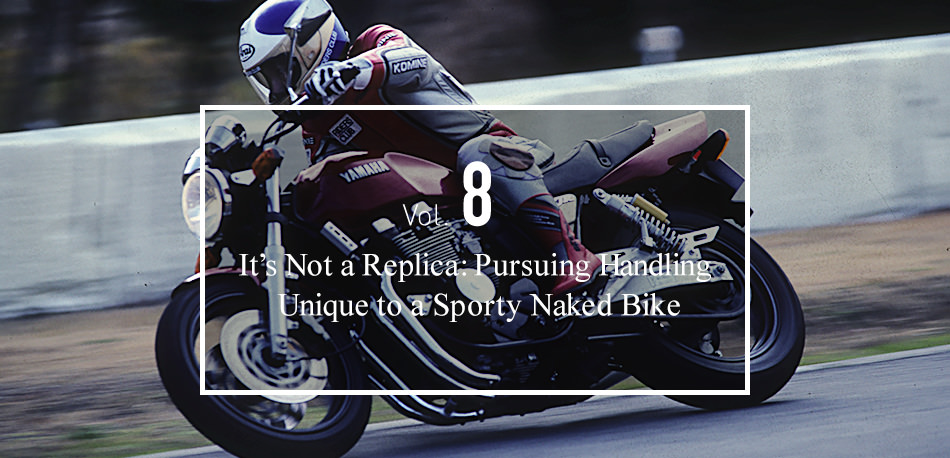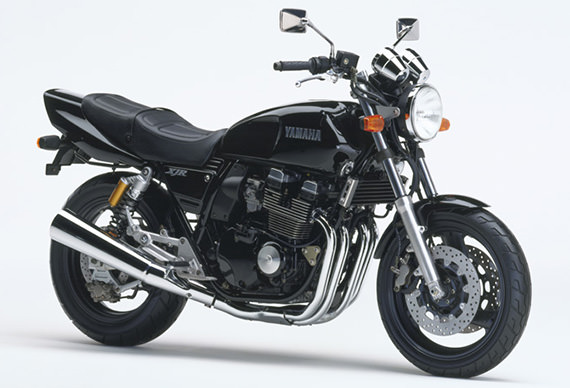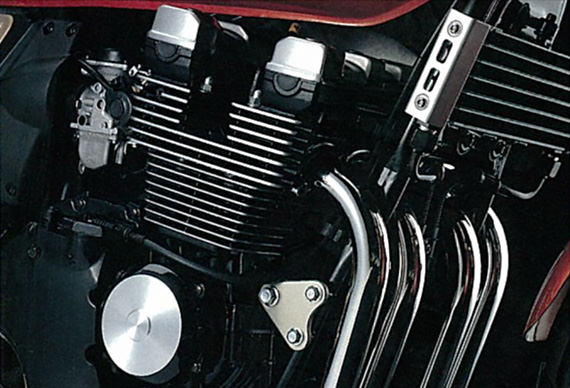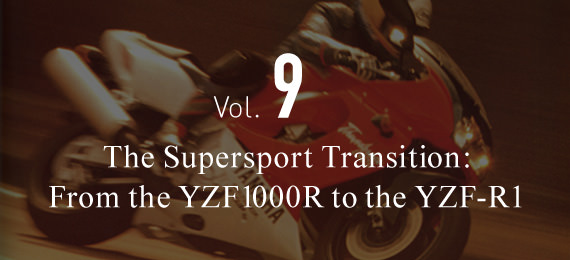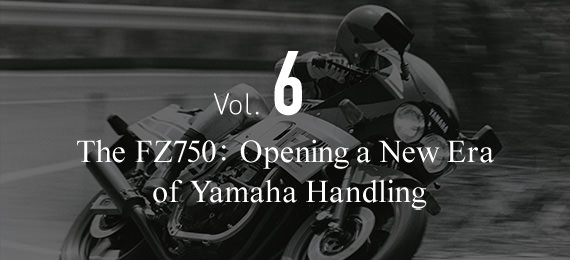Vol. 8 It’s Not a Replica: Pursuing Handling Unique to a Sporty Naked Bike
As the popularity of racer replicas faded, the Japanese domestic motorcycle market entered a “naked model” boom, and again, Yamaha Motor was a latecomer to this new trend. As everyone knows, Yamaha introduced its XJR Series in this category and the huge success this lineup of models had is still fresh in our memories. In the midst of this power struggle between the major Japanese manufacturers, the key to the success of the XJR Series was none other than Yamaha’s unwavering dedication and meticulous approach to motorcycle handling that the company had built up over the years. Yamaha believed that even with naked bikes, they should aim to create models that did not just have the nostalgic feel of conventional motorcycles from the 1970s, but also a flavor that gave them bigger appeal as sport bikes.
Yamaha built the XJR400 with an emphasis on the sporty character of a 4-cylinder engine meant to be revved and enjoyed in the high-rpm range—despite being air-cooled—and its handling was based on a strong feeling of assurance that brought the focus of riding the XJR400 to twisting the throttle and aggressively exploiting the engine in the high-rpm range. What followed was the development of the XJR1200 “big naked” model that was the result of thorough market analysis of how users rode motorcycles in Japan. The way large amounts of engine torque is delivered is another factor in determining whether a model’s handling will be advantageous or ruined, and in this regard, the XJR1200 is symbolic in the way it differed from its rival machines. It can be said that the success of these two XJR models is due to the unending pursuit of Yamaha Handling.
*The article below is a translation of a RIDERS CLUB article originally published in 1996 and contains additions and revisions.
Ken Nemoto
Born in Tokyo, Japan in 1948.
Withdrew from Keio University's Faculty of Letters.
He began riding motorcycles at age 16, won the 750cc All Japan Road Race Championship title in 1973 and competed in the World GP from 1975 to 1978. After returning to Japan, he served as the editor in chief of RIDERS CLUB magazine for 17 years and also served in producing a wide variety of hobbyist magazines. Today, he competes in the AHRMA's classic motorcycle races at Daytona Speedway as part of his life work.
Analyzing How a Naked Rides as the Category Latecomer
As the racer replica boom that had engulfed the Japanese domestic motorcycle market faded away, the naked model boom of the 1990s began. The catalyst of this new trend was none other than the Kawasaki Zephyr released in 1989. As for sport bikes without cowls, the Suzuki Bandit and Honda CB-1 were already available when the racer replica era was at its peak, but they had features that brought them closer to the character of a replica model, with clip-on handlebars and forward-leaning—and thus demanding—riding positions.
In contrast, the Zephyr’s handlebars were made of a one-piece pipe and it had a completely upright riding position. Its styling was also of a more conventional orientation; it was reminiscent of the 4-cylinder bikes during the height of their popularity in the 1970s, and this quickly turned the Zephyr into a market sensation. This change in the values held for sport bikes at the time was so great that it forced Honda to answer with their own entry by releasing the CB400 SUPER FOUR in 1992.
Yamaha had been a quiet observer of these events, but joined in by introducing the XJR400 in 1993. “Honda’s CB-1 was what got us to start considering a naked model,” says Jiro Izaki
(a member of Yamaha’s Road Testing Unit, 2nd Project Engineering Division at the time of the model’s development). The handling of these cowl-less sport bikes of the racer replica era was meant to be light and sharp, and was clearly aimed at setting their handling apart from the deep-banked cornering performance that the handling of the replica models was developed for. For Izaki and his fellow members of the testing group, these characteristics were the complete opposite of Yamaha’s handling concept of a ride character with “a feeling of assurance,” and the members were apparently quite skeptical about going in this direction in the development of handling performance.
“We began to see the direction we should take for developing our own bike in comparison to models like the CB-1 and the Bandit,” says Izaki. “While we were doing this, the Zephyr came out and sparked the naked model boom. But, the Zephyr wasn’t the kind of bike we had in mind...”
Yamaha’s developers disliked the excessive lightness and sharpness of handling that felt too sudden for the rider, but at the same time they had a definite desire for the dynamic and enjoyable performance of a sport bike. This narrowed down what the basic concept of the XJR400 would be. Izaki explains: “We were able to use all of our competitors’ bikes as references. Being latecomers to the category, this actually was an advantage for us.
“However, we had continuous discussions over where to draw the line in terms of sporty character for a naked model. There’s the enjoyable feeling of wanting to push close to the limits of the machine’s performance on a replica model, right? With a naked bike, we wanted a feeling that wouldn’t make the rider want to go that far; with a more flexible frame for example, a rider can likely get this feeling. With a replica model, the more information a rider gets from the road surface, the better, but with a naked model, over-communication to the rider of every movement of the tires and suspension leads to feelings of fear.” In this sense, the kind of ride character—the most important factor in how a bike feels to a rider—to aim for with the XJR400 became clear.
Creating Handling That Brings out the Best of the Engine
The discussions and deliberations about the XJR400’s various elements beforehand were carried out to the extent that the aforementioned decision about the XJR400’s desired character also decided the bike’s riding position. “Before, a single pipe for the handlebars and a frame made of steel pipe meant that the footpegs were usually placed in front of the swingarm pivot,” recalls Izaki. “Of course, even if that was how it was always done before the 1970s, we couldn’t retain that kind of layout with the new XJR400. However, we had been moving forward with the design work by placing the old XJ400 next to the XJR400 [prototype], so there was also some concern that the XJR400 would end up taking after the old bike in some ways. But, when the design was complete, the form was conventional, yet new. I was relieved to see that.
“My seniors were also influenced by the sales success of the Zephyr, and they advised us to ‘make a motorcycle that looks and feels like a motorcycle.’ This sounded like they were pressuring us not to develop something that was too far removed from the models creating the naked boom out of our quest for originality. ‘We mustn’t develop another old bike.’ That was what was on my mind, so I had serious hesitations [about following their advice].”
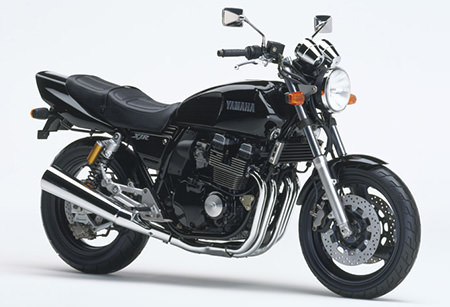
XJR400 (Released in 1993)
The XJR400 debuted in 1993 as the last entry by a Japanese manufacturer into the naked 400cc class. Its air-cooled 4-cylinder engine was tuned with a deliberate surge point mid-way through its power curve that served to accentuate the enjoyable feeling of power in the high-rpm range. The bike’s handling characteristics were tweaked to bring out the best of this engine character. The XJR400’s specs that won it a reputation as the “Fastest Air-cooled 400cc” bike, the beauty of the engine’s sculpted form and more won it a large number of fans in Japan.
In the end, the XJR400 also got a 4-cylinder engine like the competition, but it was still a bike that the rider could really enjoy by revving the engine up to the high-rpm range—despite it being air-cooled—and it was this sporty character that became its main selling point. “I remember the revs would just drop when I engaged the clutch in the low- and mid-speed ranges during the first shakedown tests,” says Yoshitaka Kojima, a member of Yamaha’s Road Testing Unit, 2nd Project Engineering Division at the time of the model’s development. He was one of the riders in charge of testing the XJR400 and he told us of what it was like back when it was under development. The Yamaha development teams had been working almost exclusively on racer replicas for nearly 10 years, so it was inevitable that the engineering methods were going to employ technology from those replica models.

The XJR400’s air-cooled, 4-valve engine(1993 year model)
Its main specs were a maximum power output of 53 PS at 11,000 rpm and maximum torque of 3.5 kgf·m at 9,500 rpm.
“The clutch wouldn’t engage unless it was at half-clutch,” says Kojima. “This wasn’t the kind of character we had in mind for our naked bike. Since we had been making replica models that would rev up to 14,000 rpm, I guess it was unavoidable that we were quite prone to doing such things. If you think about it from a big-bike perspective, there’s a danger of deciding that this was how a 400cc model should be. But, for a rider stepping up from a 50cc motorcycle, the XJR400 is a big bike. So, we wanted to place importance on the feeling of being able to engage the clutch with rougher clutch lever work.
“With the handling as well at this stage in development, the chassis, including the suspension, felt too stiff. With these settings, the bike would feel more like a replica model. I can say now we were simply overeager about certain performance aspects.”
In line with this concept of a “Yamaha-style” naked 400cc bike, the development team worked all the basic requirements into the design and engineering, but the team remained meticulous to the very end with fine-tuning the XJR400’s character to give it a sporty performance appeal.
“Once the engine goes past 4,000 rpm, the power increases comparably as the revs increase, plus we purposefully added a surge point in the power curve (a point that feels like a shift in the rising curve of engine power) at 6,000 rpm,” explains Kojima. “This ‘stepped’ curve resulted in a really enjoyable feeling when revving the engine through to the high-rpm range. Because there are regulations in place regarding engine power, we couldn’t get this fun feeling if we didn’t give the bike this kind of character. This is just one example.”
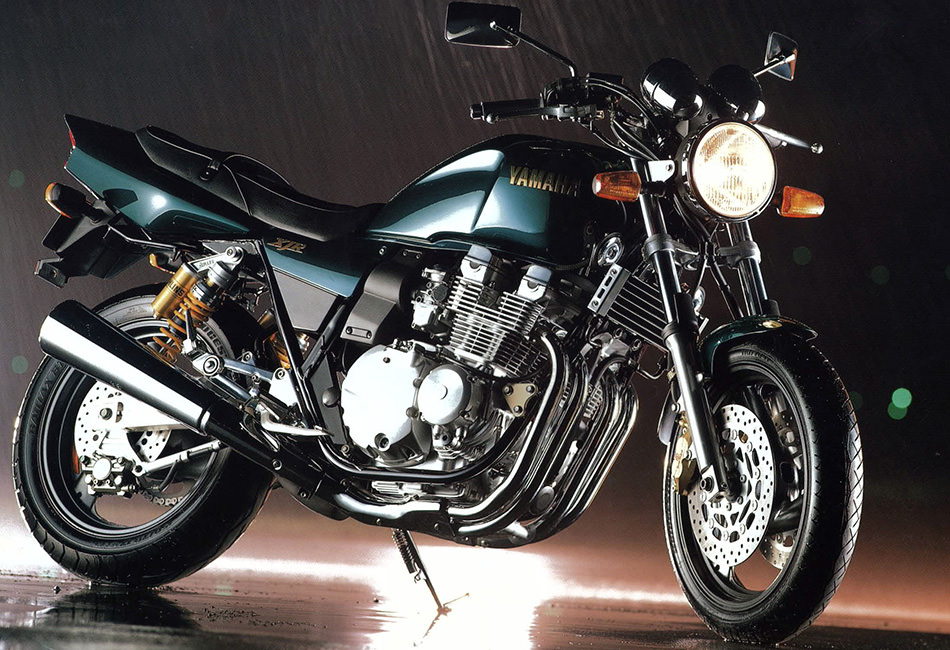
XJR400R (Released in 1995)
From 1995, the XJR400R was added to the lineup and adopted an Öhlins rear suspension and Brembo calipers for the front disc brake.
“For the suspension as well, we gave it settings to fit the speeds the bike would be traveling at when the engine was at high rpm,” Kojima continues. “At the final stage of development when we were having other Yamaha employees try out the bike, we were told that the rear suspension and the seat were stiff compared to the competitor models. We even had some uninspired negative feedback, saying things like it would be safer to just give the bike a similar feeling to that of the big-selling bikes of our rivals. Honestly, that kind of response was quite discouraging to hear. But, as the last manufacturer to join the trend, I really wanted to make the XJR400’s handling fit the character of an air-cooled 4-cylinder that was fun to ride while really revving the engine. We were very thorough in setting up the handling out on the test course.”
Put simply, a naked bike is “a conventional sport bike,” but getting the bike’s character to reflect that of an actual sport bike becomes an unexpectedly difficult and delicate challenge once you have the technological capability to easily achieve high performance with a machine. In the end, it came down to not giving up on Yamaha’s policy of creating handling that gives the rider a feeling of assurance, and the XJR400 was released boasting a very precise balance of this feeling and a spirited ride character. After its debut, the XJR400 almost immediately became a top-seller in Japan.
(Continue to Part 2)
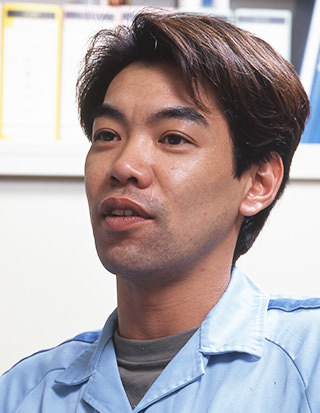

Yoshitaka Kojima, a member of Yamaha’s Road Testing Unit, 2nd Project Engineering Division at the time of the interview


